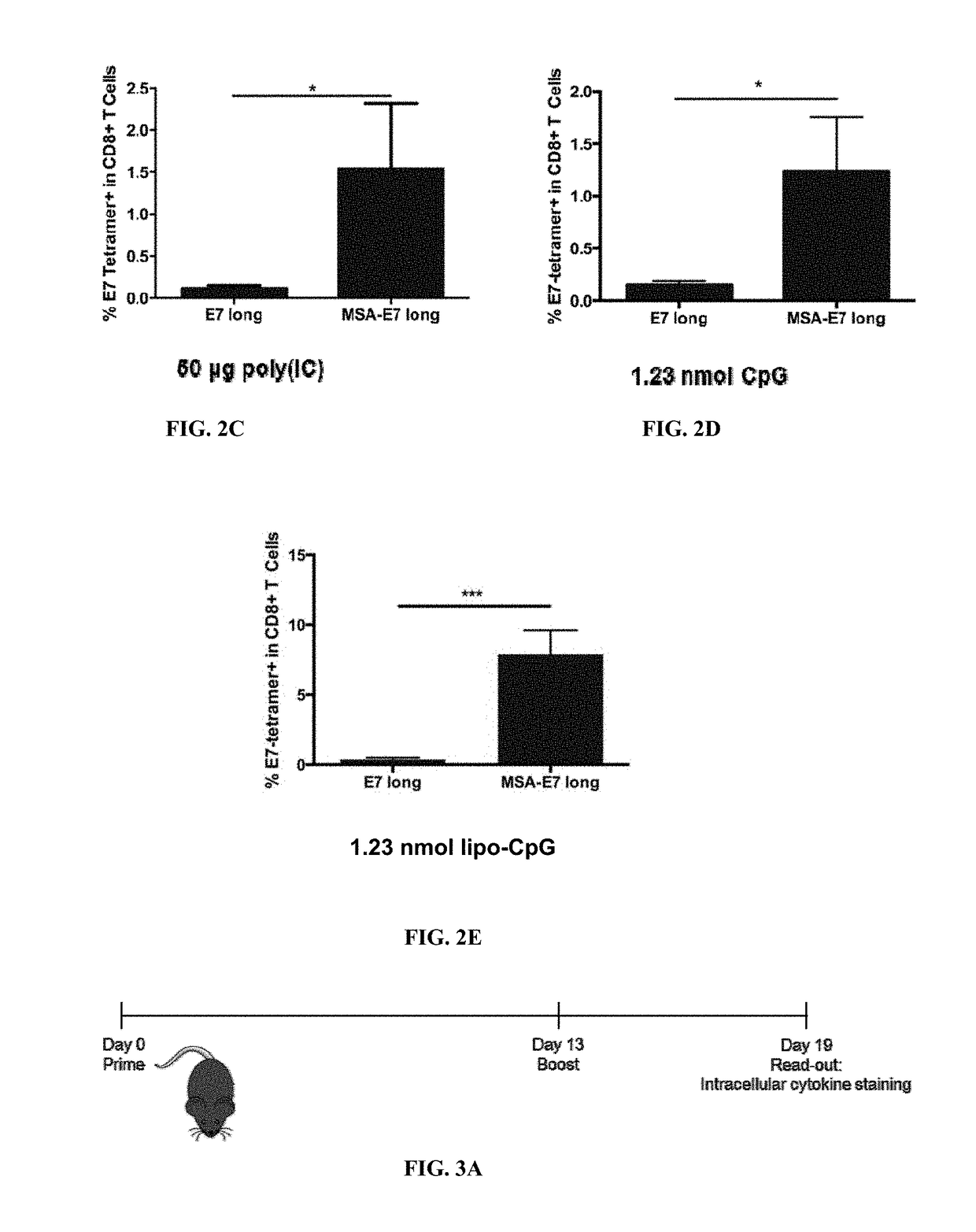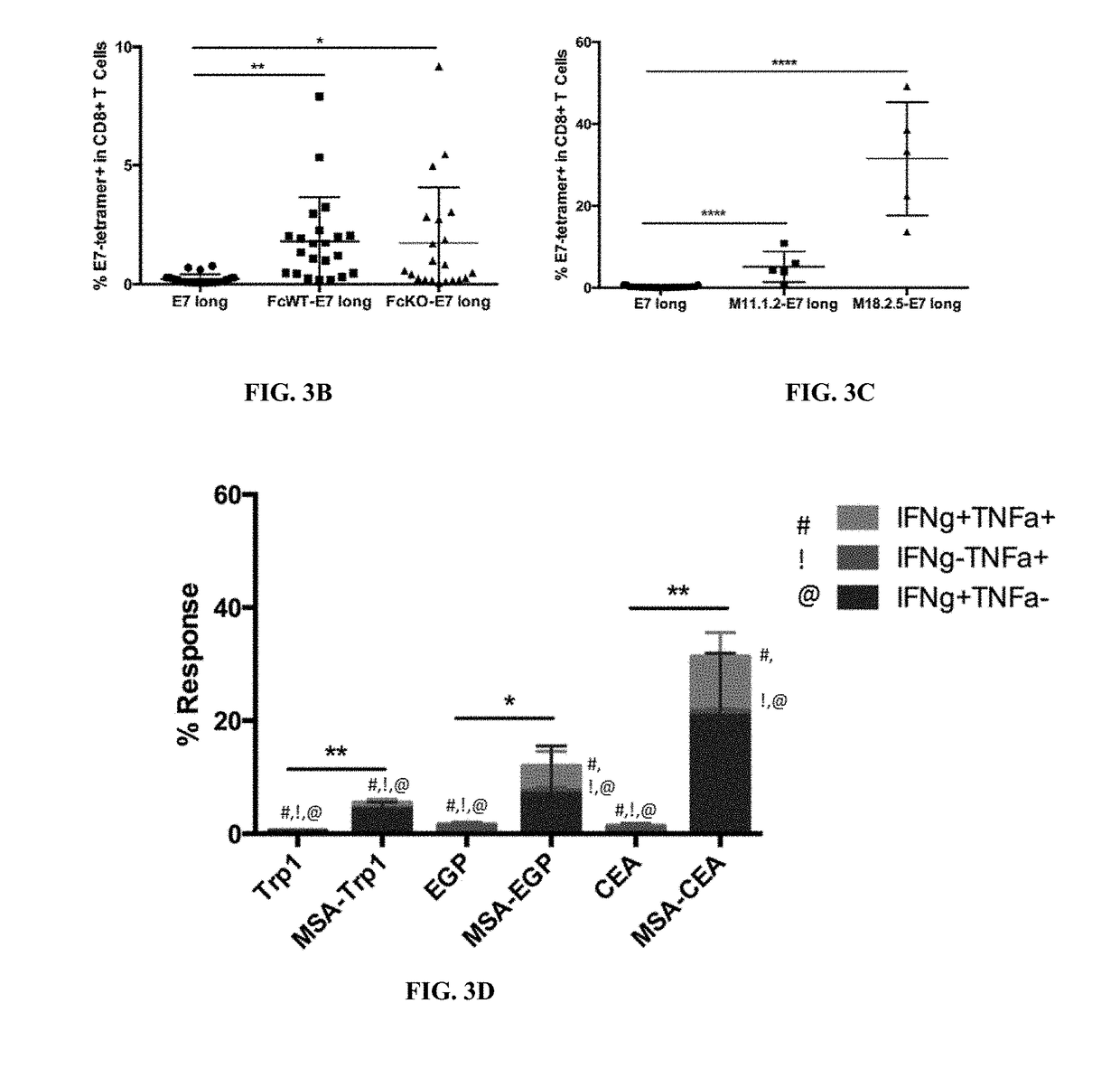Protein-chaperoned t-cell vaccines
a t-cell vaccine and protein technology, applied in the field of protein antigens, can solve the problems of lagged clinical success of cancer vaccines, achieve the effects of improving immune response, increasing antigen-specific proliferation of t cells, and increasing lymph node uptak
- Summary
- Abstract
- Description
- Claims
- Application Information
AI Technical Summary
Benefits of technology
Problems solved by technology
Method used
Image
Examples
example 1
haperoned Vaccines Traffic to the Lymph Nodes and Enhance T Cell Vaccines
[0330]Materials and Methods
[0331]Mouse Model
[0332]The experimental mouse model includes C57BL / 6 mice subcutaneously injected with antigen and adjuvant. During vaccination, antigen and adjuvant are co-injected on separate molecules. Vaccines are typically performed in a prime / boost schedule: mice are primed on day 0 with antigen and adjuvant, boosted on day 14 homologously, and bled on day 20, when either tetramer staining or intracellular cytokine staining are employed to measure vaccine response. One experiment utilized the alternative schedule of prime at day 0, boost at day 13, and bled at day 19. The results indicate that the alternative schedule does not substantially alter the results.
[0333]In tetramer analysis, vaccine response was measured by collecting 100 ul of peripheral blood from vaccinated mice 6 days following boost, lysing red blood cells with ACK lysing buffer, and using an E7 tetramer to measu...
example 2
haperones Enhance Tumor Regression
[0356]Materials and Methods
[0357]MSA-CEA Study
[0358]Lung adenocarcinoma cell lines were transfected with a human CEA transgene. 1×106 CEA-expressing lung adenocarcinoma cells were implanted subcutaneously into the flanks of transgenic C57BL / 6 mice expressing human CEA. On day 6 after tumor initiation, mice were vaccinated subcutaneously at the left and right tail base with 360 μg (equivalent to 10 μg of the CEA 567-584 peptide) of MSA-CEA567-584 peptide fusion and 1.2 nmol of lipo-CpG. Immediately after vaccination, mice were treated intra-peritoneally with 30 μg of MSA-IL-2 and 8 mg / kg each of anti-CEA antibody (SM3e, mouse IgG2a isotype), anti-PD1 (Clone RMP1-14, rat IgG2a isotype) and anti-CTLA4 (Clone 9D9, mouse IgG2a isotype). Mice received this combination immunotherapy every 7 days for 5 weeks. Tumor area was measured every other day and mice were sacrificed when tumor area exceeded 200 mm2.
[0359]MSA-E7 Long Peptide Study
[0360]B6 mice were in...
example 3
etin (TTR) is Effective as a Protein Chaperon
[0367]Materials and Methods
[0368]TTR-E7 long was prepared in the same fashion as MSA-E7 long. Because TTR is a tetramer, there are four copies of E7 long peptide cargo per protein. As a result, 25 μg of TTR-E7 long were compared against 100 μg MSA-E7 long in a prime boost vaccination model. Six days after boost, 100 μl of peripheral blood was collected from vaccinated and naïve mice. Red blood cells were lysed using ACK lysing buffer. Remaining cells were labeled with an E7-specific MHC tetramer to measure the fraction of circulating E7-specific CD8 T cells.
[0369]TTR-Trp1, TTR-EGP long, and TTR-CEA long were prepared in the same fashion as the MSA-antigen fusions described above. Like in the E7 long experiment, mice were dosed with 1 / 4 as much TTR-antigen fusion compared to MSA-antigen fusion. In the case of TTR-Trp1 and TTR-EGP long, however, responses were more than doubled when TTR was used as a vaccine carrier. TTR-CEA long was equiva...
PUM
| Property | Measurement | Unit |
|---|---|---|
| Composition | aaaaa | aaaaa |
| Flexibility | aaaaa | aaaaa |
| Molecular weight | aaaaa | aaaaa |
Abstract
Description
Claims
Application Information
 Login to View More
Login to View More - R&D
- Intellectual Property
- Life Sciences
- Materials
- Tech Scout
- Unparalleled Data Quality
- Higher Quality Content
- 60% Fewer Hallucinations
Browse by: Latest US Patents, China's latest patents, Technical Efficacy Thesaurus, Application Domain, Technology Topic, Popular Technical Reports.
© 2025 PatSnap. All rights reserved.Legal|Privacy policy|Modern Slavery Act Transparency Statement|Sitemap|About US| Contact US: help@patsnap.com



